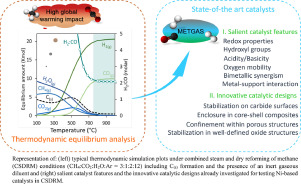Journal of Energy Chemistry ( IF 14.0 ) Pub Date : 2020-01-02 , DOI: 10.1016/j.jechem.2019.12.017 Karam Jabbour

|
Nowadays, combined steam and dry reforming of methane (CSDRM) is viewed as a new alternative for the production of high-quality syngas (termed as “metgas”, H2:CO of 2.0) suitable for subsequent synthesis of methanol, considered as a promising renewable energy vector to substitute fossil fuel resources. Adequate operation conditions (molar feed composition, temperature and pressure) are required for the sole production of “metgas” while achieving high CH4, CO2 and H2O conversion levels. In this work, thermodynamic equilibrium analysis of CSDRM has been performed using Gibbs free energy minimization where; (i) the effect of temperature (range: 200–1000 °C), (ii) feed composition (stoichiometric ratio as compared to a feed under excess steam or excess carbon dioxide), (iii) pressure (range: 1–20 bar) and, (iv) the presence of a gaseous diluent on coke yields, reactivity levels and selectivity towards “metgas” were investigated. Running CSDRM at a temperature of at least 800 °C, a pressure of 1 bar and under a feed composition where CO2+H2O/CH4 is around 1.0, are optimum conditions for the theoretical production of “metgas” while minimizing C(s) formation for longer experimental catalytic runs. A second part of this work presents a review of the recent progresses in the design of (principally) Ni-based catalysts along with some mechanistic and kinetic modeling aspects for the targeted CSDRM reaction. As compared to noble metals, their high availability, low cost and good intrinsic activity levels are main reasons for increasing research dedications in understanding deactivation potentials and providing amelioration strategies for further development. Deactivation causes and main orientations towards designing deactivation-resistant supported Ni nanoparticles are clearly addressed and analyzed. Reported procedures based on salient catalytic features (i.e., acidity/basicity character, redox properties, oxygen mobility, metal-support interaction) and recently employed innovative tactics (such as confinement within mesoporous systems, stabilization through core shell structures or on carbide surfaces) are highlighted and their impact on Ni0 reactivity and stability are discussed. The final aspect of this review encloses the major directions and trends for improving synthesis/preparation designs of Ni-based catalysts for the sake of upgrading their usage into industrially oriented combined reforming operations.
中文翻译:

调整蒸汽和甲烷的干重整相结合以生产“气”:一种热力学方法和最先进的催化剂
如今,结合蒸汽和甲烷的干法重整(CSDRM)被视为生产高质量合成气(称为“ metgas”,H 2:CO为2.0)的新选择,该合成气适合于随后的甲醇合成,被认为是一种有前途的可再生能源载体替代化石燃料资源。单独生产“甲烷”需要足够的操作条件(摩尔进料组成,温度和压力),同时要获得较高的CH 4,CO 2和H 2。O转换级别。在这项工作中,已经使用吉布斯自由能最小化对CSDRM进行了热力学平衡分析。(i)温度的影响(范围:200–1000°C),(ii)进料组成(与在过量蒸汽或过量二氧化碳下的进料相比,化学计量比),(iii)压力(范围:1–20 bar ),以及(iv)研究了气态稀释剂对焦炭收率,反应性水平和对“甲烷”选择性的影响。在至少800°C的温度,1 bar的压力下以及在CO 2 + H 2 O / CH 4约为1.0的进料组成下运行CSDRM是理论上生产“甲烷”同时将C最小化的最佳条件(s)形成更长的实验催化运行。这项工作的第二部分介绍了(主要)Ni基催化剂设计的最新进展以及针对目标CSDRM反应的一些机理和动力学建模方面的内容。与贵金属相比,它们的高可用性,低成本和良好的内在活性水平是增加研究力度以了解失活潜力并为进一步发展提供改善策略的主要原因。已明确解决和分析了失活的原因和设计抗失活负载的Ni纳米颗粒的主要方向。根据重要的催化特征(例如,酸度/碱性,氧化还原性质,氧迁移率,讨论了0反应性和稳定性。这篇综述的最后一个方面概述了改善镍基催化剂的合成/制备设计的主要方向和趋势,以便将其用途升级为工业导向的联合重整操作。











































 京公网安备 11010802027423号
京公网安备 11010802027423号